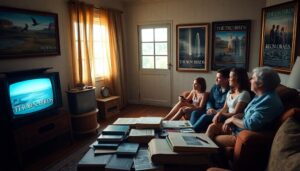C. S. Lewis began writing "The Lion, the Witch, and the Wardrobe" in 1949 after he was inspired by a picture of a faun in a snowy forest. His goal was to entertain evacuated British children during World War II. By March 1949, the manuscript was complete, and it was officially published on October 16, 1950. Many personal and professional challenges influenced its creation, and there's much more to its fascinating story.
The Initial Inspiration for Narnia

Although C. S. Lewis drew inspiration from a simple picture of a faun carrying an umbrella in a snowy wood, that image sparked his imagination and led to the creation of Narnia.
By 1946, the idea of a wardrobe as a portal to a magical world was already forming in his mind. During World War II, as British children were evacuated, Lewis wanted to entertain them with his fantasy stories. This desire culminated in "The Lion, the Witch and the Wardrobe," which he completed by March 1949. The theme of magical realism in his work enhances the emotional depth and connection to the characters and their struggles, as readers are drawn into epic quests that challenge the protagonists.
The character of Aslan emerged unexpectedly, becoming a pivotal figure that tied the story together and influenced the entire Narnian saga. Aslan's character embodies the themes of sacrifice and redemption, reflecting the deeper moral lessons intertwined in the narrative.
The Writing Process and Timeline
As C.S. Lewis initiated the writing process for "The Lion, the Witch and the Wardrobe" in 1949, inspiration struck from a vivid image of a faun in a snowy wood.
By March's end, he completed the manuscript, enthusiastic to share his creation. Lewis sent it to Lucy Barfield, his friend's daughter, in May, setting in motion its journey toward publication. This creative process bears similarities to Aldous Huxley's own literary career as both authors drew from personal experiences and societal observations in their works. Notably, Lewis's storytelling also reflects elements of genre diversity found in the science fiction genre, showcasing a blend of imagination and thematic depth.
The timeline progressed quickly, with the manuscript submitted to Geoffrey Bles Ltd. on July 29 and the publication contract signed on August 13.
After much anticipation, "The Lion, the Witch and the Wardrobe" officially hit the shelves on October 16, 1950, marking the beginning of the beloved Chronicles of Narnia series. This work has since been recognized as a classic space opera that captivates readers with its imaginative storytelling and rich themes.
Key Life Events During Writing

As you explore the key life events during the writing of "The Lion, the Witch and the Wardrobe," you'll notice how personal challenges shaped C.S. Lewis's journey.
From dealing with exhaustion and the loss of loved ones to the impact of new relationships, each experience influenced his creativity. The struggles faced by immigrant communities in early 20th-century settings resonate with the themes of resilience that Lewis also embedded in his work. Embracing a growth mindset allowed Lewis to channel his struggles into meaningful narratives, enriching the depth of his characters and their journeys.
Understanding these dynamics gives you a deeper appreciation for the story's development. Additionally, like Richard Yates, Lewis also grappled with disillusionment and personal struggles that informed his writing and character development.
Personal Challenges Faced
While crafting "The Lion, the Witch and the Wardrobe," C.S. Lewis faced numerous personal struggles that shaped his writing process.
The emotional impact of the death of his close friend, Mrs. Moore, in January 1951 weighed heavily on him, influencing the tone of the Chronicles. His increased workload at Magdalen College, Oxford, added to his exhaustion, leading to hospitalization during this period.
Family issues, particularly his brother Warren's alcoholism, further strained Lewis's emotional state. Amidst these challenges, his developing relationship with Joy Davidman in September 1952 introduced new dynamics, coinciding with the completion of the series.
These experiences intertwined to create a unique backdrop for one of literature's most beloved tales.
Influence of Relationships
The relationships in C.S. Lewis's life profoundly influenced his emotional state and creative output during the writing of "The Lion, the Witch, and the Wardrobe."
Key connections shaped his writing process and themes:
- The death of his companion, Mrs. Moore, deepened his emotional struggles.
- Joy Davidman's entry into his life provided newfound support and inspiration.
- Increased pressures from teaching and his brother's alcoholism heightened personal struggles.
- Roger Lancelyn Green's feedback refined the manuscript, enhancing its depth.
These dynamics not only impacted Lewis's emotional state but also enriched the narrative with themes of struggle and resilience, reflecting his personal journey through relationships that shaped his creative vision.
The Role of Roger Lancelyn Green
Roger Lancelyn Green played a pivotal role in the development of "The Chronicles of Narnia," serving as a trusted confidant to C.S. Lewis.
Throughout the editorial process, Green was instrumental in shaping Lewis's narratives, offering valuable insights and feedback that refined the stories for publication. Their collaborative relationship blossomed as Green received various drafts and updates, including details about "The Magician's Nephew." Historical fiction books often highlight remarkable women overcoming societal challenges, paralleling the themes of courage and resilience found in Lewis's work. This partnership not only enhanced the storytelling but also reflected the power of collective action in literature, as they worked together to create a lasting legacy.
After the death of Lewis's friend Mrs. Moore, Green's involvement deepened when he received the manuscript of "The Silver Chair."
This connection highlights how Green's support was essential during Lewis's literary endeavors, showcasing their commitment to creating a timeless series that continues to resonate with readers today. The importance of collaboration in literature is evident in their partnership, emphasizing how shared ideas can enhance storytelling.
The Journey From Draft to Publication

You'll discover how C.S. Lewis transformed his initial ideas into the beloved tale of Narnia. From the early drafting process to key milestones and the challenges he faced along the way, each step played a significant role in shaping the final book. Resilience and inner strength were vital in overcoming the obstacles Lewis encountered during his writing journey. The themes of healing and empowerment in storytelling can be seen in how Lewis navigated through personal struggles to create a narrative that resonates with readers. Much like Charles Dickens' own experiences with social injustice, Lewis's background influenced his writing and the themes he explored. Let's explore the journey that brought "The Lion, the Witch, and the Wardrobe" to life.
Early Drafting Process
While crafting "The Lion, the Witch and the Wardrobe," C.S. Lewis wrote his first manuscript in 1949, fueled by an image of a faun with an umbrella in a snowy wood. His imagination blossomed into a narrative that would capture readers for generations.
The early drafting process was highly collaborative, where he incorporated feedback from others, including Lucy Barfield.
Key aspects of this process included:
- The initial inspiration from fairy tales
- The completion of the manuscript by March 1949
- Submission to Geoffrey Bles Ltd. on July 29, 1949
- The book being published on October 16, 1950
This groundwork laid the foundation for a beloved classic that emerged from Lewis's creative journey.
Key Milestones Timeline
From the moment C.S. Lewis began writing "The Lion, the Witch, and the Wardrobe" in 1949, inspired by a vivid dream and an image of a faun, a magical journey took shape.
By March's end, he'd completed the manuscript and sent it to Lucy Barfield by May. After beta testing with children, he submitted the manuscript to Geoffrey Bles Ltd on July 29, 1949.
Finally, on October 16, 1950, the book was published, marking the first release in *The Chronicles of Narnia*.
"The Lion, the Witch, and the Wardrobe" quickly became the best-known of the seven novels, establishing a remarkable legacy in children's literature that continues to enchant readers today.
Publication Challenges Faced
Despite C.S. Lewis's enthusiasm for fantasy, he faced significant challenges in bringing *The Lion, the Witch and the Wardrobe* to publication.
After submitting his manuscript on July 29, 1949, the initial critical response was muted, reflecting a preference for realistic children's stories. Still, he persevered, signing the contract on August 13, 1949, marking a pivotal moment in his career.
Key challenges included:
- Resistance to fantasy themes
- The editing process involving Roger Lancelyn Green
- Development of the manuscript through feedback
- Balancing expectations of publishers and readers
Ultimately, the novel was published in the UK on October 16, 1950, becoming the first of the seven Chronicles of Narnia to be released.
Thematic Elements in the Story
Thematic depth enriches "The Lion, the Witch and the Wardrobe," inviting readers to explore profound conflicts and moral lessons.
At its core, the struggle of good vs. evil unfolds through the battle between Aslan and the White Witch, embodying Narnia's plight. Aslan's sacrifice for Edmund emphasizes themes of sacrifice and redemption, mirroring deeper Christian motifs.
The narrative revolves around prophecy fulfillment, heralding the arrival of the Pevensie siblings, who evolve into heroic figures amid their coming-of-age journey. Their growth highlights moral challenges faced in a fantastical domain.
Furthermore, the bonds of friendship and loyalty among the Pevensie siblings and their allies, like Mr. and Mrs. Beaver, showcase the crucial role of unity in overcoming adversity throughout this enchanting children's fantasy.
Reception and Legacy of the Novel
Upon its release, "The Lion, the Witch and the Wardrobe" faced a lukewarm reception, as critics favored realistic children's literature over fantasy.
However, the novel eventually gained significant acclaim and is now celebrated for its impact on both genres.
Here are a few reasons for its enduring popularity:
- It's sold over 120 million copies worldwide.
- The book has been adapted into various films and stage productions.
- It features rich moral lessons and imaginative storytelling.
- It ranks highly in literary polls, including BBC's "The Big Read."
Today, you can see the global appeal of "The Lion, the Witch and the Wardrobe," as it remains a beloved staple in children's literature, enchanting young readers across generations.
Illustrations and Their Impact
Illustrations play an essential role in bringing "The Lion, the Witch and the Wardrobe" to life, enhancing your journey into the magical domain of Narnia. Created by Pauline Baynes, these illustrations reflect the fantastical elements that C.S. Lewis envisioned.
The British edition boasts 43 illustrations, while American versions often include fewer, sometimes only 17 cropped images. Lewis valued Baynes's work so much that he praised her in a letter after she won the Carnegie Medal.
The restored images in the 1994 HarperCollins edition have a slightly reduced clarity, yet they still contribute to the book's enduring appeal. Ultimately, Baynes's visual representation enriches your imaginative experience, allowing you to fully immerse yourself in the enchanting world of Narnia.
The Broader Context of the Chronicles of Narnia
C.S. Lewis crafted *The Chronicles of Narnia* during World War II, inspired by the need for escapism for evacuated children. His first book, *The Lion, the Witch and the Wardrobe*, blends adventure with moral lessons through magical creatures and rich storytelling.
Key elements of the Narnia series include:
- Exploration of moral themes
- Imaginative world-building
- Reflection of wartime experiences
- Lasting impact on children's literature
Lewis's interactions with children influenced his narratives, making the Narnian stories resonate deeply.
Conclusion
In exploring the origins of "The Lion, the Witch, and the Wardrobe," you uncover a world where creativity sparked, where imagination soared, and where storytelling thrived. You see how C.S. Lewis's life intertwined with his writing, how inspiration transformed into a beloved tale, and how timeless themes resonate still. As you close the book, you can feel the magic of Narnia lingering, inviting you to return, to dream, and to believe in adventure once more.



